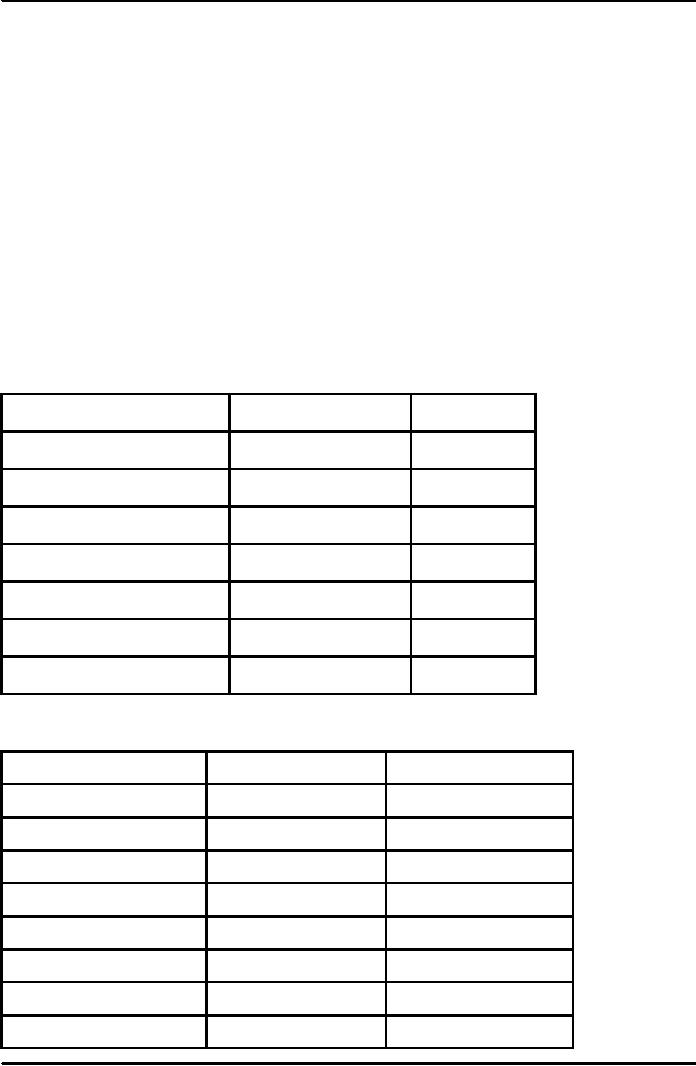 |
NON- VERBAL COMMUNICATION:Environmental Factors |
| << NON- VERBAL COMMUNICATION:Analysing Nonverbal Communication |
| TRAITS OF GOOD COMMUNICATORS:Careful Creation of the Message >> |

VU
Lesson
7
NON-
VERBAL COMMUNICATION
Type
Examples
Vocal
characterizers laughing, crying, sighing,
yawning, clearing the
throat,
groaning,
yelling, whispering
Vocal
Qualifiers
intensity
(loud/soft); pitch height
(high/low).
Vocal
Segregates
sounds
such a `uh-huh', `um', `uh'; silent
pauses.
Proximity
(Use of Space)
�
Proximity
means nearness, in terms of
physical space. How people
use their personal space
and
that
of others communicates a message. This
response to spatial relationships in
formal, informal
and
intimate setting indicates
how that person perceives
and feels in that
space.
�
People
also use their height
and weight to convey a message. If
you tower over other people
in a
way
that intrudes on their personal
space you may cause
their discomfort and
withdrawal.
�
Personal
space varies according
to:
�
Gender
�
Status
�
Roles
�
Culture
�
Research
has shown that Australians
speaking to acquaintances or work
colleagues leave about
an
arm's
length of space between
themselves and the other
person. People speaking to friends
and
family
leave about half an arm or an
elbow's length between
themselves and others.
People in
intimate
relationships allow direct and close
contact when speaking to
each other. The use of
space
reflects
the way people feel about others.
Artifacts
�
Artifacts
are objects used to convey
nonverbal messages about self-concept,
image, mood, feeling
or
style. For example, perfume,
clothes, lipstick, glasses and
hairpieces project the style or
mood of
the
wearer. Many artifacts are
common to the group but we also
use artifacts, particularly
clothing,
as
an individual form of
communication.
�
Appearance
and cloth are important
and highly visible parts of
nonverbal communication. Consider
the
different between the clothes
you wear to the beach and
the clothes you wear to a
job interview.
The
choice of clothes reflects
your mood and your
attitude to the occasion. Other people
note and
place
their own interpretation on
your dress.
�
Even
if you decide you will
not bother about personal
appearance or clothes, others
will read this
message
as part of your nonverbal
communication.
Environmental
Factors
�
The
environment can influence the outcome of
communication. For this reason, organization
gives
careful
consideration to office space, factory layout, the
sales area and conference
venues. The
environment
should put people at ease and
match their expectations; an
unsuitable environment
can
produce `noise' that causes
communication barriers and interferes
with the communication
process.
17

VU
�
Certain
instincts, such as desire
for privacy, familiarity and
security, need to be satisfied.
Careful
design
of the workplace can meet these
needs and in so doing
improve communication,
productivity
and morale. Natural and
artificial light, colour,
temperature, tables, chairs,
desks,
lounges,
plants, sound, artwork,
magazines, and floor and
wall coverings all have an
impact on
people's
perception of an organization.
�
In
the workplace, attention to punctuality
or a disregard for it can
make a strong nonverbal
impact.
A
disregard for punctuality
may, like a sloppy appearance,
merely reflect a casual attitude.
However,
a
deliberate decision to keep a
contact waiting may be a way
to communicate a negative
message.
�
While
punctuality is a matter of courtesy,
attitudes towards its
important vary between cultures.
To
be
kept waiting for a business
appointment on a tropical island
will not have the same
significance
as
a delay in some European counties
where punctuality is highly
regard.
�
The
above discussion of the seven
aspects of nonverbal communication provides a
theoretical
analysis.
However, to consider each
aspect in isolation is artificial. In
practice, what is sent as a
total
message
is a cluster of nonverbal cues in
association with the spoken
words
Your
Response to Behaviour
Nonverbal
Behaviour
Teacher
Student
Body
movement
Physical
characteristics
Touching
behaviour
Vocal
qualities
Use
of Space
Artifacts
Environment
Your
Response to an Organization
Characteristics
Organization
I Like
Organization
I dislike
Atmosphere
Use
of space
Smells
Colour
Service
Building
Inclusions
and fittings
Sounds
18
Table of Contents:
- COMMUNICATION:Definition of Communication, Communication & Global Market
- FLOW OF COMMUNICATION:Internal Communication, External Communication
- THEORIES OF COMMUNICATION:Electronic Theory, Rhetorical Theory
- THE PROCESS OF COMMUNICATION & MISCOMMUNICATION:Message
- BARRIERS IN EFFECTIVE COMMUNICATION /COMMUNICATION FALLOFF
- NON- VERBAL COMMUNICATION:Analysing Nonverbal Communication
- NON- VERBAL COMMUNICATION:Environmental Factors
- TRAITS OF GOOD COMMUNICATORS:Careful Creation of the Message
- PRINCIPLES OF BUSINESS COMMUNICATION:Clarity
- CORRECTNESS:Conciseness, Conciseness Checklist, Correct words
- CONSIDERATION:Completeness
- INTERCULTURAL COMMUNICATION
- INTERCULTURAL COMMUNICATION:Education, Law and Regulations, Economics
- INDIVIDUAL CULTURAL VARIABLES:Acceptable Dress, Manners
- PROCESS OF PREPARING EFFECTIVE BUSINESS MESSAGES
- Composing the Messages:THE APPEARANCE AND DESIGN OF BUSINESS MESSAGES
- THE APPEARANCE AND DESIGN OF BUSINESS MESSAGES:Punctuation Styles
- COMMUNICATING THROUGH TECHNOLOGY:Email Etiquette, Electronic Media
- BASIC ORGANIZATIONAL PLANS:Writing Goodwill Letters
- LETTER WRITING:Direct Requests, Inquiries and General Requests
- LETTER WRITING:Replies to Inquiries, Model Letters
- LETTER WRITING:Placing Orders, Give the Information in a Clear Format
- LETTER WRITING:Claim and Adjustment Requests, Warm, Courteous Close
- LETTER WRITING:When The Buyer Is At Fault, Writing Credit Letters
- LETTER WRITING:Collection Letters, Collection Letter Series
- LETTER WRITING:Sales Letters, Know your Buyer, Prepare a List of Buyers
- MEMORANDUM & CIRCULAR:Purpose of Memo, Tone of Memorandums
- MINUTES OF THE MEETING:Committee Members’ Roles, Producing the Minutes
- BUSINESS REPORTS:A Model Report, Definition, Purpose of report
- BUSINESS REPORTS:Main Features of the Report, INTRODUCTION
- BUSINESS REPORTS:Prefatory Parts, Place of Title Page Items
- MARKET REPORTS:Classification of Markets, Wholesale Market
- JOB SEARCH AND EMPLOYMENT:Planning Your Career
- RESUME WRITING:The Chronological Resume, The Combination Resume
- RESUME & APPLICATION LETTER:Personal Details, Two Types of Job Letters
- JOB INQUIRY LETTER AND INTERVIEW:Understanding the Interview Process
- PROCESS OF PREPARING THE INTERVIEW:Planning for a Successful Interview
- ORAL PRESENTATION:Planning Oral Presentation, To Motivate
- ORAL PRESENTATION:Overcoming anxiety, Body Language
- LANGUAGE PRACTICE AND NEGOTIATION SKILLS:Psychological barriers
- NEGOTIATION AND LISTENING:Gather information that helps you
- THESIS WRITING AND PRESENTATION:Write down your ideas
- THESIS WRITING AND PRESENTATION:Sections of a Thesis (Format)
- RESEARCH METHODOLOGY:Studies Primarily Qualitative in Nature
- RESEARCH METHODOLOGY:Basic Rules, Basic Form, Basic Format for Books